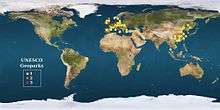Geopark
A geopark is a unified area that advances the protection and use of geological heritage in a sustainable way, and promotes the economic well-being of the people who live there.[1] There are global geoparks and national geoparks.

Concepts
A UNESCO definition of global geopark is a unified area with a geological heritage of international significance.[2] Geoparks use that heritage to promote awareness of key issues facing society in the context of our dynamic planet. Many geoparks promote awareness of geological hazards, including volcanoes, earthquakes and tsunamis and many help prepare disaster mitigation strategies with local communities. Geoparks embody records of past climate changes and are indicators of current climate changes as well as demonstrating a "best practise" approach to using renewable energy and employing the best standards of "green tourism". Tourism industry promotion in geoparks, as a geographically sustainable and applicable tourism model, aims to sustain, and even enhance, the geographical character of a place.
Geoparks also inform about the sustainable use and need for natural resources, whether they are mined, quarried or harnessed from the surrounding environment while at the same time promoting respect for the environment and the integrity of the landscape. Geoparks are not a legislative designation though the key heritage sites within a geopark are often protected under local, regional or national legislation.[2] The multidisciplinary nature of the concept of geopark and tourism promotion in geoparks differentiates itself from other models of sustainable tourism. In fact, sustainable tourism promotion within geoparks encompasses many of the features of sustainable tourism including geo-tourism (geo-site tourism: as a basic factor), community-based tourism and integrated rural tourism (as a vital need), ecotourism, and cultural heritage tourism.
Global Network and UNESCO
The Global Geoparks Network (GGN) is supported by United Nations Educational, Scientific and Cultural Organization (UNESCO). Many national geoparks and other local geoparks projects also exist which are not included in the Global Geoparks Network.
The geoparks initiative was launched by UNESCO in response to the perceived need for an international initiative that recognizes sites representing an earth science interest.[3] Global Geoparks Network aims at enhancing the value of such sites while at the same time creating employment and promoting regional economic development.[3] The 195 Member States of UNESCO ratified the creation of a new label, the UNESCO Global Geoparks, on 17 November 2015.[4] This expressed governmental recognition of the importance of managing outstanding geological sites and landscapes in a holistic manner. This new designation formalized UNESCO's relationship with the Global Geoparks Network. The Global Geoparks Network works in synergy with UNESCO's World Heritage Centre and Man and the Biosphere (MAB) World Network of Biosphere Reserves.
Qualification
The Global Geoparks Network (GGN) was established in 1998 and received ad hoc support from UNESCO from 2001 until 2015, when the relationship and designation was formalized. Since 2015, members are officially designated by UNESCO, as UNESCO Global Geoparks.[4] According to the Statutes and Operational Guidelines of the UNESCO Global Geoparks[5], for a geopark to apply to be included in the GGN, it needs to:
- have a management plan designed to foster socio-economic development that is sustainable based on geotourism
- demonstrate methods for conserving and enhancing geological heritage and provide means for teaching geoscientific disciplines and broader environmental issues
- have joint proposals submitted by public authorities, local communities and private interests acting together, which demonstrate the best practices with respect to Earth heritage conservation and its integration into sustainable development strategies.[6] [7]
Members of the GGN
See also
- Geotourism
- Global Geoparks Network
- African Geoparks Network
- Asia Pacific Geoparks Network
- European Geoparks Network
- Latin America and the Caribbean Geoparks Network
- List of National Geoparks
References
- Patrick J. Mc Keever and Nickolas Zouros (2005). Geoparks: Celebrating earth heritage, sustaining local communities. EPISODES, December 2005, pp. 274–278.
- "What is a Global Geopark? | United Nations Educational, Scientific and Cultural Organization". UNESCO. Retrieved 2015-08-16.
- "About—UNESCO's role in geopark initiative". Geopark Iskar Panega website. Geopark Iskar Panega. 2007. Archived from the original on 2014-03-19.
- "UNESCO Press release: UNESCO gives Global Geoparks a new label". UNESCO. UNESCO. 17 November 2015. Retrieved 7 January 2020.
- "Statutes and Operational Guidelines of the UNESCO Global Geoparks". UNESCO Global Geoparks. Retrieved 7 January 2020.
- 'April 2010 GEO4B/PM Advanced Level Examination - Advanced Information Booklet'
- "Fundamental features of UNESCO Global Geoparks". UNESCO Global Geoparks. Retrieved 7 January 2020.
External links
| Wikimedia Commons has media related to Geoparks. |